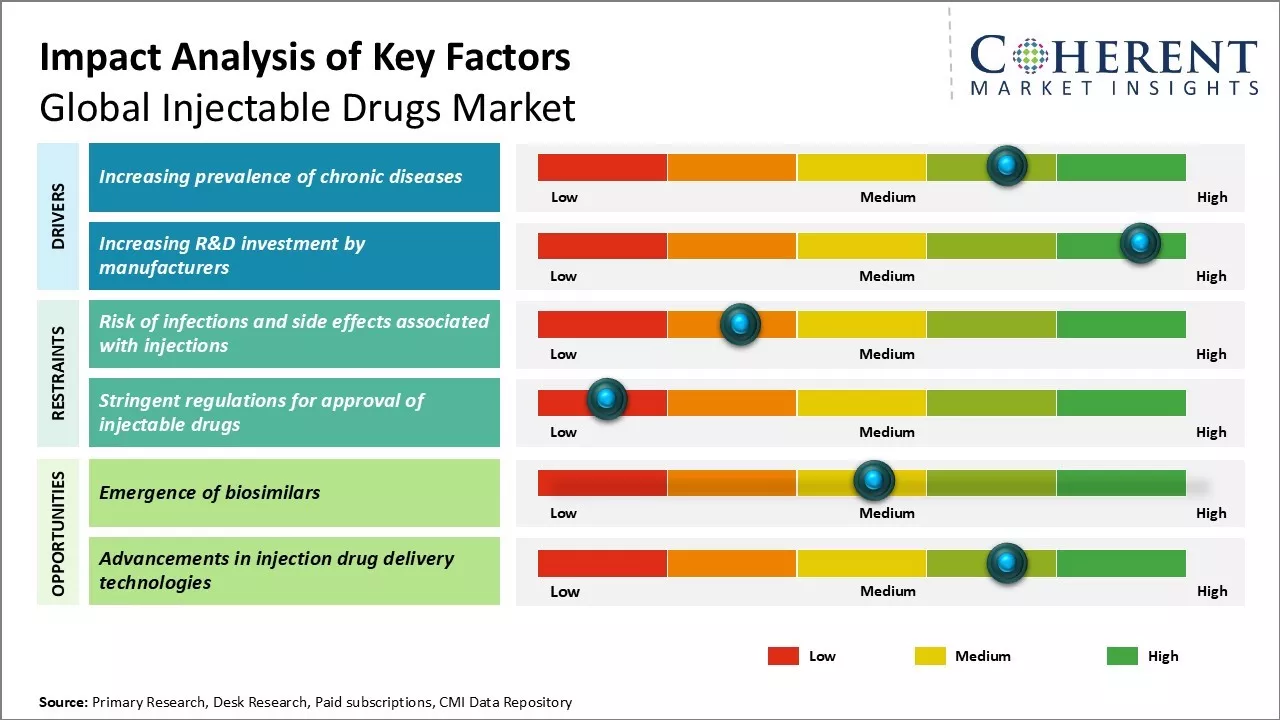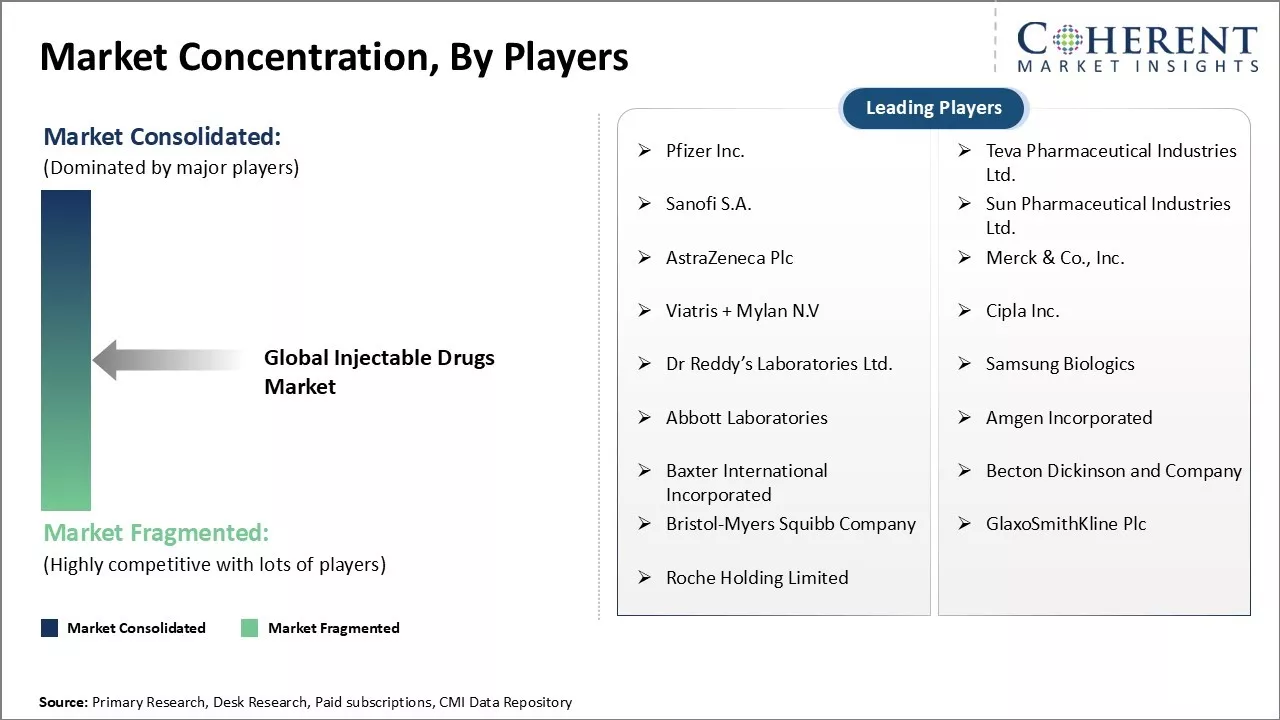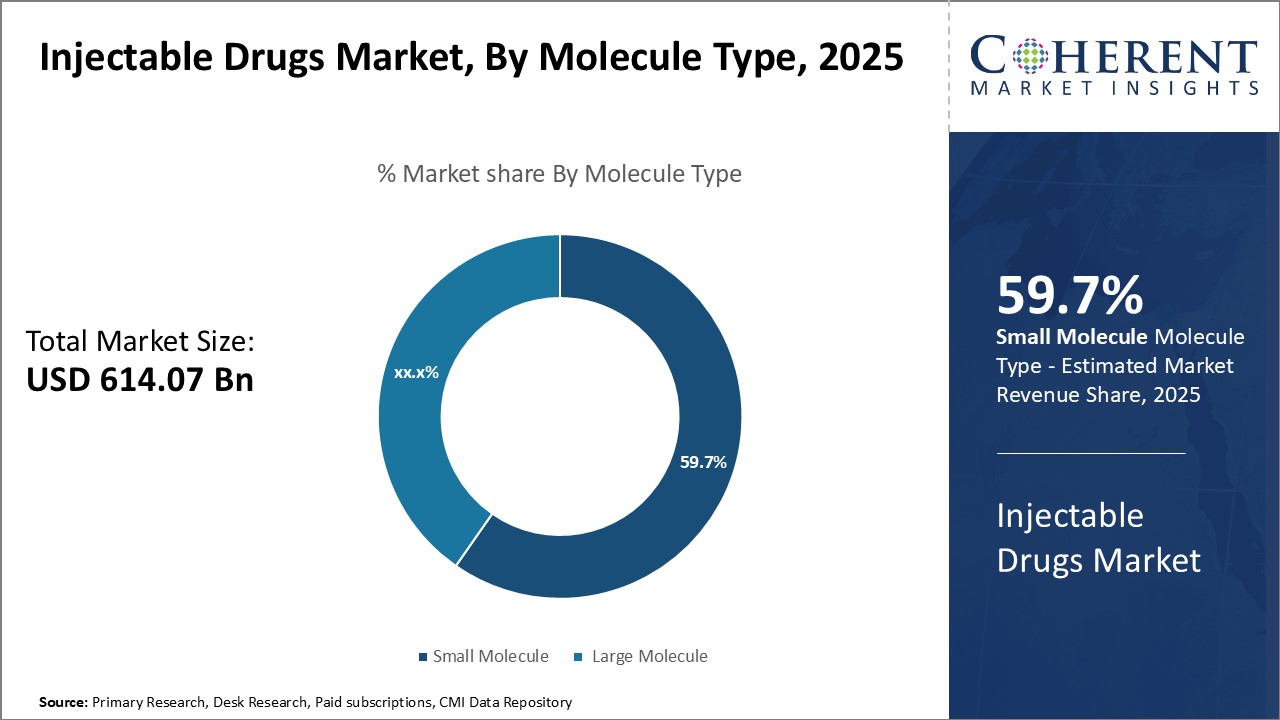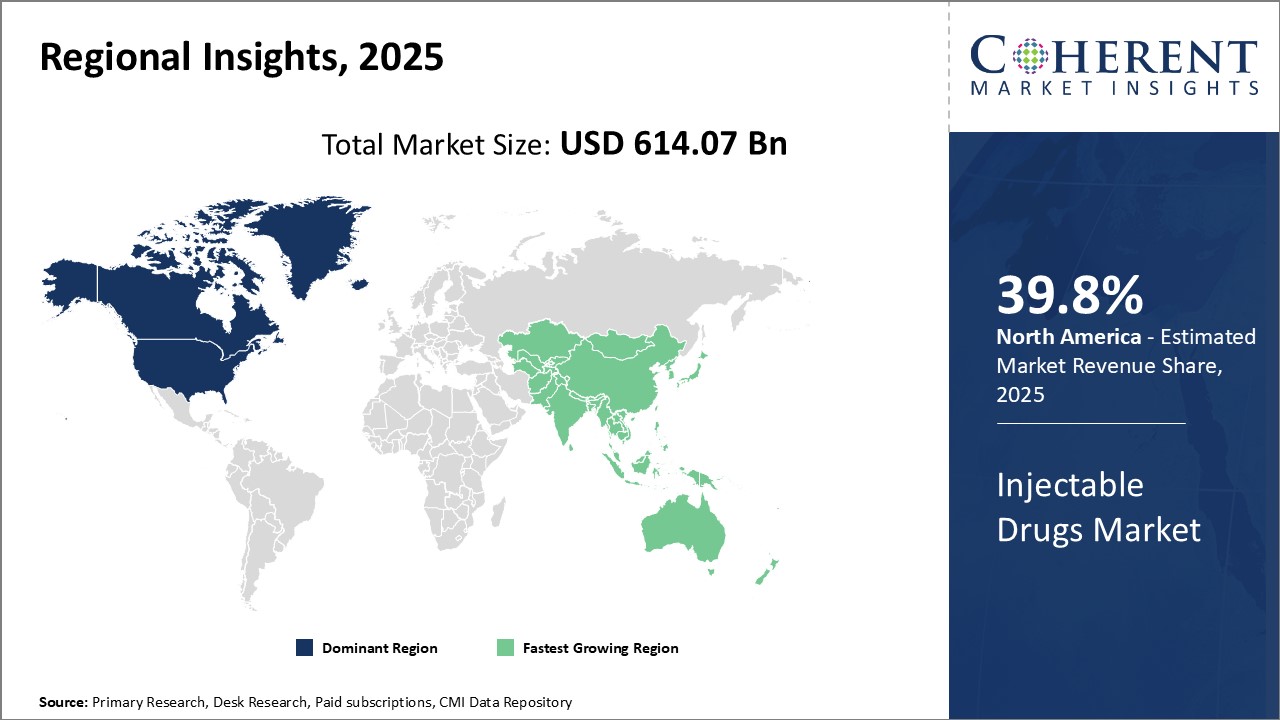Global injectable drugs market is estimated to be valued at USD 614.07 Billion in 2025 and is expected to reach USD 1,032.78 Billion by 2032, exhibiting a compound annual growth rate (CAGR) of 7.7% from 2025 to 2032.

Discover market dynamics shaping the industry: Request sample copy
Rising prevalence of chronic diseases worldwide can boost demand for injectable drugs. Furthermore, injectable formulations enhance bioavailability and produce immediate systemic effects as compared to oral formulations. Self-injectable drugs allow patients to conveniently administer medications at home and preventive medicines are being developed in injectable forms. Advancements in drug delivery technologies can expand the indications that can be treated using injectable drugs. Growing biologics and large molecule injectables used for treating conditions such as cancer and autoimmune diseases can drive the market growth.
Increasing prevalence of chronic diseases
Rising prevalence of chronic diseases can drive the market growth. Chronic diseases such as cancer, diabetes, cardiovascular diseases and respiratory diseases have become one of the major causes of mortality and disability worldwide. According to WHO, chronic diseases accounted for approximately 70% of all deaths globally in 2020. Even in developing countries which were earlier mostly affected by infectious diseases, chronic diseases are increasingly becoming a leading health problem.
Growing burden of chronic diseases poses significant economic challenges for healthcare systems around the world. Treatment of chronic conditions requires long term medication and therapy, which boosts demand for injectable drugs. Many modern drug development approaches are focused on developing drugs which can be self-administered through injections at home. This allows for improved convenience and compliance over oral administration methods. Chronic diseases also require frequent monitoring of the condition through lab testing and diagnostics. Injectable drugs play a vital role in disease management by allowing targeted and controlled delivery of the required medication directly into systemic circulation. Therapeutic areas like oncology, autoimmune diseases extensively rely on injectables due to their advantages over oral drugs.
Lifestyle changes such as sedentary routines, unhealthy diets and substance abuse have significantly contributed to rise in incidence of chronic medical conditions. Rapidly growing and aging global population susceptible to age-related diseases can increase the prevalence of chronic diseases in the near future. Unless concrete preventive measures are taken, it is estimated that chronic diseases will remain one of the major health challenges for the foreseeable future. This growing chronic disease burden coupled with limitations of alternative treatment methods has boosted demand for injectable drugs worldwide.

Get actionable strategies to beat competition: Request sample copy
Increasing R&D investment by manufacturers
Pharmaceutical companies worldwide have substantially increased their spending on research and development activities over the past few years. Developing new and improved drug delivery mechanisms has been a key priority area. Injectable drug delivery offers several advantages over conventional oral administration such as targeted delivery, sustained release and quicker onset of action. These advantages drive significant R&D efforts towards development of novel and specialized injectable drug formulations.
Modern biologics and large molecule drugs have exponential growth opportunities, however, pose delivery challenges. Injectables provide a viable solution through formulations like pre-filled syringes, auto-injectors and implantable pumps. Substantial investments are dedicated to applying advanced drug formulation and delivery technologies such as microencapsulation, nanoparticle drug carriers and controlled release injectable depots. Such innovations allow delivery of drugs which were previously considered unsuitable for injection. Complex biologics are increasingly being developed in safer, stable and patient friendly injectable forms.
Moreover, injectable drug digitization is revolutionizing medication management. Combination of drug delivery devices, sensors and connectivity platforms enable development of “Intelligent” injectables with capabilities like automatic dosing, wireless health monitoring. Such “Digital therapeutics” are being co-developed along with traditional injectable drugs to improve clinical outcomes. Significant R&D spending is focused on such combination product development approaches. Overall advancement in materials, engineering and data science boosts introduction of human centric specialized injectable products with augmented functionalities.
Key Takeaways from Analyst:
Global injectable drugs market growth is driven by increasing prevalence of chronic diseases such as cancer, diabetes and cardiovascular diseases. Rising geriatric population who are more susceptible to chronic conditions also boosts demand for injectable medications.
North America currently dominates the injectable drugs market, owing to high healthcare spending and more advanced medical facilities. However, Asia Pacific is anticipated to be the fastest growing regional market due to rising healthcare standards, growing medical tourism industry and surging patient population in major Asian countries.
Stringent regulations associated with injectable drugs development and manufacturing can hamper the market growth. Potential risks of contamination during production can also hamper the market growth. Furthermore, complexity involved in delivery mechanism and stability testing of injectable medications increases their development costs.
Growing demand for targeted and personalized therapy can offer growth opportunities. Self-injection devices are gaining more popularity among patients requiring long-term injectable treatment due to convenience provided by these deveices. Advancements in injection technologies including prefilled syringes, auto-injectors and pen injectors offer enhanced usability. The emergence of biosimilars provides an opportunity to reduce healthcare costs and improve access to expensive biologic drugs.
Market Challenges: Risk of infections and side effects associated with injections
Global injectable drugs market growth can be hampered due to risk of infections and side effects associated with injections. Injections can occasionally cause infections like sepsis, cellulitis or abscesses at the injection site, if proper sterile procedures are not followed. Injections may also cause hematomas, ulcers or nerve damage at the injection site. Intravenous injections carry higher risks, if contaminated fluids enter the bloodstream. Self-injecting medications like insulin at home also entails the risk of accidental needle sticks, which could potentially spread blood-borne infections like HIV, hepatitis B or C. Side effects of injectable drugs could range from mild reactions like pain, redness, swelling at the injection site to life-threatening systemic allergic reactions or anaphylaxis in sensitive individuals. The risks associated with injections makes them unpopular options as compared to oral medications.
Market Opportunities: Emergence of biosimilars for market
The emergence of biosimilars presents a major growth opportunity for the global injectable drugs market. Biosimilars are biological products that are similar to an already approved biological reference product known as the originator biologic. As patents of many blockbuster biologics expire, multiple pharmaceutical companies are developing biosimilars of those products. This increases treatment options for patients and physicians apart from lowering healthcare costs significantly compared to originator biologics. The uptake of affordable biosimilars is expected to be faster in the injectable segment as parenteral administration remains the preferred route for many monoclonal antibody drugs and other biologics. The biosimilars market is projected to grow substantially in the near future, thus, creating abundant opportunities for injectable drug manufacturers. This can enhance access to lifesaving therapies and propel the expansion of the worldwide injectable drugs market.

Discover high revenue pocket segments and roadmap to it: Request sample copy
By Molecule Type- The dominance of cost-effective treatments
By molecule type, small molecule segment is estimated to contribute the highest market share of 59.7% in 2025, owing to its affordability. Small molecule drugs have been the mainstay of treatment for various therapeutic areas due to their affordability and ease of production. Being composed of relatively smaller organic compounds, small molecule drugs have low production costs as compared to large molecule biologics. Their simple structure also makes them suitable for generic development, further, enhancing access and reducing costs for patients worldwide.
A major factor driving the use of small molecule drugs is their prevalence in areas like oncology, cardiovascular diseases and anti-infectives, which account for the bulk of disease burden. Many first line treatments and standard of care regimens in these therapeutic segments rely on small molecule formulations. For instance, drugs like paclitaxel, docetaxel and oxaliplatin constitute the first line chemotherapeutic regimens in breast, lung and colorectal cancers. Antibiotics, anti-hypertensives and statins form the mainstay of infectious disease, cardiovascular and endocrine treatments globally.
The off-patent status of many important small molecule drugs also promotes their affordability and widespread prescribing. The availability of low cost generic versions of blockbuster drugs like atorvastatin, enoxaparin and sunitinib has transitioned treatment to the generic small molecule counterparts. Biosimilars have captured a sizeable share of markets of off-patent blockbuster biologics, thus, shifting treatment paradigms.
Ease of administration through the parenteral route including intravenous, intramuscular and subcutaneous injections has further increased the acceptability of small molecule drugs. While large molecules often require specialized delivery methods, small molecules can be formulated into ready-to-use vials, pre-filled syringes and intravenous infusions to facilitate outpatient and ambulatory care. This supports treatment convenience and adherence.
Strong cost advantages, prevalence in high volume disease areas and supportive intellectual property status have cemented the leading position of the small molecule segment in the global injectable drugs market.
By Route of Administration- Administration route dominance
By route of administration, intravenous segment is estimated to contribute the highest market share of 40.5% in 2025, due to its effectiveness. Intravenous therapy witness widespread adoption due to its effectiveness in delivering drugs systemically. Being the most direct non-oral administration method, intravenous injections deliver drugs to the bloodstream immediately after administration. This allows rapid achievement of therapeutic drug concentrations without reliance on gastrointestinal absorption.
This is a major advantage in several clinical situations like emergency treatment of conditions including infections, cardiac events, hemorrhagic shock and even cancer. Timely systemic delivery of drugs is critical in these life-threatening conditions requiring immediate clinical response. The effectiveness of intravenous route has made it the preferred way of drug administration in hospitalized patients and critical care.
Intravenous injections are also useful for drugs that are either not absorbed or inactivated after oral/enteral administration. Examples are antibacterials, antifungals, chemotherapeutics, anticoagulants and some parenteral nutrition formulas. Direct venous access ensures the entire bioavailable dose reaches the systemic circulation from first pass metabolism or gastrointestinal degradation.
From a patient standpoint, intravenous therapy enables non-oral administration for those unable to take medications orally - like unconscious or vomiting patients. It is also utilized for conditions requiring controlled and precise delivery of drugs on fixed schedules, as the rate and amount injected can be carefully regulated.
The technical expertise required in administering intravenous injections through cannulated veins is a drawback limiting its use to hospital-based and skilled ambulatory care. However, high efficacy outcomes has ensured intravenous route maintains its primacy in the global injectable drugs market over others like intramuscular or subcutaneous.
By Therapeutic Area- Oncology contributes the highest share of the market, owing to rising cancer burden
By therapeutic area, Oncology segment is estimated to contribute the highest market share of 35.5% in 2025, due to escalating incidence rates of cancer worldwide. Cancer has replaced cardiovascular diseases as the leading cause of death globally, responsible for nearly 10 million lives lost in 2020. Growing aging population prone to cancers, adoption of lifestyle changes and other environmental risk factors have all contributed to the tremendous rise in new cancer cases annually across all regions.
Multimodality treatment approach in oncology also drives the segment growth. Most cancer regimens involve a combination of surgery, radiation, chemotherapy and newer targeted or immunotherapy agents. Among these modalities, injectable chemotherapy in the form of intravenous or subcutaneous infusions represents the mainstay of treatment for majority of cancer types and stages worldwide. The permanence of chemotherapy also boosts use of these drugs.
Biologics constitute a notable share of novel oncology treatments now available. These injectable monoclonal antibody and immune-checkpoint inhibitors play the role of first line therapy or successors to chemotherapy. Examples include Avastin, Keytruda and Opdivo with multi-billion dollar annual sales worldwide. Furthermore, biologics and biosimilars approvals can sustain new injectable additions in oncology.
Geographical expansion of cancer care can also drive the segment growth. Economic development of Asian and African countries is improving access to sophisticated care like injectable chemotherapy and targeted therapies previously limited to developed markets. This widening treatment availability boosts injectable oncology drugs market volume internationally. Heightened cancer screening and focus on reduced out of pocket costs of treatment can aid penetration globally.

Need a Different Region or Segment? Customize now
North America dominates the global injectable drugs market with an estimated market share of 39.8% in 2025, due to the strong presence of major pharmaceutical companies in the region, especially in the U.S. Many top drug makers have their headquarters, R&D centres and manufacturing facilities based in North America. These are able to benefit from advanced research infrastructure and expertise available in the region. Close collaboration between industry and research institutes also helps foster innovation. Large healthcare expenditure and higher demand for specialty drugs from an aging population to treat chronic conditions like diabetes and cancer can contribute to North America’s prominence. The region also has minimal price controls and pharmaceutical companies enjoy intellectual property protection, allowing them to charge premium prices.
Asia Pacific is expected to emerge as fastest growing region, due to massive patient population suffering from both communicable and lifestyle diseases. This has increased demand for therapeutics significantly. Infectious diseases like tuberculosis remain prevalent in developing Asian countries. Non-communicable illnesses related to changing lifestyles are also increasing. Countries such as China and India have become major production hubs for pharma manufacturing to meet both local and global demands. Many international pharma giants are actively seeking to expand and establish operations in Asia Pacific to tap into its fast-growing markets as well as benefit from lower costs. Asia Pacific countries have also been taking initiatives to enhance healthcare infrastructure and provide low-cost treatment options. Their focus on import substitution has attracted investments into local manufacturing of injectables. This can expand accessibility while reducing dependence on imports.
Injectable Drugs Market Report Coverage
| Report Coverage | Details | ||
|---|---|---|---|
| Base Year: | 2024 | Market Size in 2025: | USD 614.07 Bn |
| Historical Data for: | 2020 To 2024 | Forecast Period: | 2025 To 2032 |
| Forecast Period 2025 to 2032 CAGR: | 7.7% | 2032 Value Projection: | USD 1,032.78 Bn |
| Geographies covered: |
|
||
| Segments covered: |
|
||
| Companies covered: |
Pfizer Inc., Teva Pharmaceutical Industries Ltd., Sanofi S.A., Sun Pharmaceutical Industries Ltd., AstraZeneca Plc, Merck & Co., Inc., Viatris + Mylan N.V, Cipla Inc., Dr Reddy’s Laboratories Ltd., Samsung Biologics, Abbott Laboratories, Amgen Incorporated, Baxter International Incorporated, Becton Dickinson and Company, Bristol-Myers Squibb Company, GlaxoSmithKline Plc, Roche Holding Limited |
||
| Growth Drivers: |
|
||
| Restraints & Challenges: |
|
||
Uncover macros and micros vetted on 75+ parameters: Get instant access to report
*Definition: Global injectable drugs market encompasses pharmaceutical medications designed for administration through needle-based injections or infusions into patients. This market includes a variety of common injectable drugs, such as vaccines, insulin, antibodies, chemotherapeutic agents, and analgesics. These products are administered via different routes, including intravenous, intramuscular, and subcutaneous injections, and are used in both chronic disease management and acute treatments within hospitals and clinics.
Share
Share
About Author
Ghanshyam Shrivastava - With over 20 years of experience in the management consulting and research, Ghanshyam Shrivastava serves as a Principal Consultant, bringing extensive expertise in biologics and biosimilars. His primary expertise lies in areas such as market entry and expansion strategy, competitive intelligence, and strategic transformation across diversified portfolio of various drugs used for different therapeutic category and APIs. He excels at identifying key challenges faced by clients and providing robust solutions to enhance their strategic decision-making capabilities. His comprehensive understanding of the market ensures valuable contributions to research reports and business decisions.
Ghanshyam is a sought-after speaker at industry conferences and contributes to various publications on pharma industry.
Missing comfort of reading report in your local language? Find your preferred language :
Transform your Strategy with Exclusive Trending Reports :
Frequently Asked Questions
Joining thousands of companies around the world committed to making the Excellent Business Solutions.
View All Our Clients
US Reciprocal Tax Impact Analysis On Injectable Drugs Market
Stay updated on tariff changes with expert insights and timely information